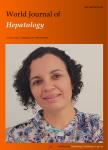Silymarin in non alcoholic fatty liver disease
Silymarin in non alcoholic fatty liver disease作者机构:Department of Internal Medicine and Geriatrics Second University of Naples
出 版 物:《World Journal of Hepatology》 (世界肝病学杂志(英文版)(电子版))
年 卷 期:2013年第5卷第3期
页 面:109-113页
学科分类:1002[医学-临床医学] 100201[医学-内科学(含:心血管病、血液病、呼吸系病、消化系病、内分泌与代谢病、肾病、风湿病、传染病)] 10[医学]
主 题:Alanine aminotransferase Aspartate aminotransferase Total cholesterol Gamma-glutamyl transpeptidase Non alcoholic fatty liver disease Silymarin Steato test Hepatorenal ultrasonographic index Fasting glucose level High density lipoprotein and low density lipoprotein cholesterol Homeostatic model assessment insulin resistance test
摘 要:AIM: This study was undertaken to evaluate the hepatic effects of silybum marianum on non alcoholic fatty liver disease (NAFLD). METHODS: In 72 patients affected by NAFLD, main metabolic, hepatic and anti-inflammatory parameters were assayed after 3 mo of a restricted diet and before silymarin treatment (twice a day orally). The brightness of liver echography texture (hepatorenal ratio brightness) was also defined at same time. These evaluations were repeated after 6 mo of treatment. RESULTS: Serum levels of some metabolic and anti-inflammatory data nonsignificantly lowered after 6 mo of silymarin. On the contrary, Steato test, alanine aminotransferase (ALT), aspartate aminotransferase (AST) and gamma-glutamyl transpeptidase were significantly (P 0.001) reduced. Instead, the AST/ALT ratio unchanged. Finally, the hepatorenal brightness ratio, as an index of hepatic steatosis, significantly (P 0.05) dropped. CONCLUSION: The obtained results indicate that silymarin appears to be effective to reduce the biochemical, inflammatory and ultrasonic indices of hepatic steatosis. Some parameters indicative of early stage of atherosclerosis were also lowered.



